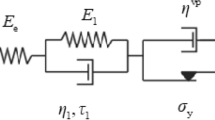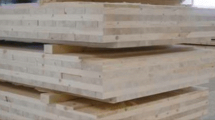Abstract
In order to investigate the creep and duration-of-load (DOL) effects in thick strand-based wood composite products, a creep-rupture model is proposed linking the accumulated damage to creep deformation. Results from long-term constant load tests have been interpreted by means of this creep-rupture model, which is capable of representing the time-dependent deflection and time-to-failure data at different stress levels. The predictions of the model have been verified using results from ramp load test at different rates of loading. The creep-rupture model incorporates the short-term strength of the material, the load history and predicts the deflection history as well as the time-to-failure. As it is a probabilistic model, it allows its incorporation into a time-reliability study of wood composites’ applications.







Similar content being viewed by others
References
Dinwoodie JM, Higgins JA, Robson DJ, Paxton BH (1990) Creep in chipboard, Part 7: testing the efficacy of models on 7–10 years data and evaluating optimum period of prediction. Wood Sci Technol 24:181–189
Flügge W (1967) Viscoelasticity. Blaisdell Pub. Co., Massachusetts, Toronto, London, p 33
Foschi RO, Barrett JD (1982) Load duration effects in western hemlock lumber. J Struct Div ASCE 108(7):1494–1510
Foschi RO, Yao FZ (1986) Another look at the three duration of load models. In: Proceedings of IUFRO wood engineering group meeting, Florence, Italy, paper 19-9-1
Foschi RO, Folz BR, Yao FZ (1989) Reliability-based design of wood structures. Dept. of Civil Engineering, University of British Columbia, Vancouver, BC, pp 38–66
Foschi RO, Folz BR, Yao FZ (1993) RELAN: Reliability Analysis User’s Manual. Civil Engineering Department, University of British Columbia, Vancouver, Canada, p 51
Kiureghian AD, Liu P (1986) Structural reliability under incomplete probability information. J Eng Mech 112(1):85–105
Nielsen LF (1986) Wood as a cracked viscoelastic material. Part I: theory and applications, and part II: sensitivity and justification of a theory. In: Proceedings of international workshop on duration of load in lumber and wood products, Richmond, BC, Canada, Special Publ. No. SP-27, Forintek Canada Corp., Vancouver, BC, pp 67–89
Pierce CB, Dinwoodie JM, Paxton BH (1985) Creep in chipboard, Part 5: an improved model for prediction of creep deflection. Wood Sci Technol 19:83–91
Yao FZ (1987) Reliability of structures with load history-dependent strength and an application to wood members, Master thesis, Dept. of Civil Engineering, University of British Columbia
Author information
Authors and Affiliations
Corresponding author
Rights and permissions
About this article
Cite this article
Wang, J.B., Foschi, R.O. & Lam, F. Duration-of-load and creep effects in strand-based wood composite: a creep-rupture model. Wood Sci Technol 46, 375–391 (2012). https://doi.org/10.1007/s00226-011-0401-7
Received:
Published:
Issue Date:
DOI: https://doi.org/10.1007/s00226-011-0401-7




